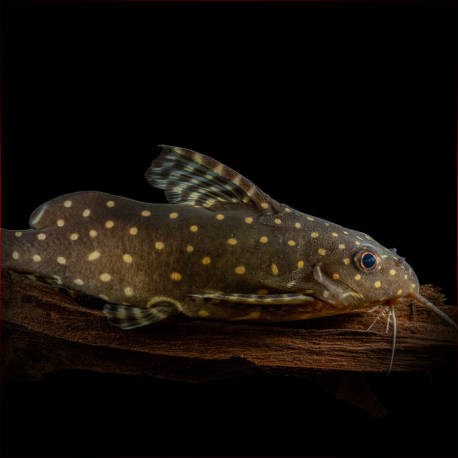More info
Datasheet
| Minimum Tank Size | 200 litres / 52.83 US gallons |
| Maximum Size | 25.0cm / 9.84inches |
| Temperature | 24°C / 75.20°F - 28°C / 82.40°F |
| Hardness | 3-20ºdH |
| pH | 6.0-8.0 |
General Description:
The Polka Dot Synodontis, scientifically known as Synodontis Angelicus, is a species of catfish belonging to the family Mochokidae. It is characterized by its long lifespan, capable of surviving for over 20 years if provided with proper care. The coloration and patterning of this species vary significantly based on its type locality, with some individuals featuring white or yellow spotting, while the base color ranges from grey to black. Additionally, some specimens may display areas of barring on their bodies. The Polka Dot Synodontis is also referred to as the Angel Synodontis.
Aquarium Setup:
To create a suitable environment for the Polka Dot Synodontis in captivity, a tank with a minimum capacity of 200 liters is recommended. The ideal tank setup includes a soft substrate, rocks, pieces of driftwood, and twisted roots arranged to provide hiding places for the fish. Floating vegetation is suggested to help diffuse the light entering the tank, with additional planting being beneficial but not mandatory. The water conditions should have a hardness ranging from 3 to 20 degrees of general hardness (dH), a pH level between 6.0 and 8.0, and a temperature maintained between 24 to 28 degrees Celsius.
Behaviour:
Known for its nocturnal behavior, the Polka Dot Synodontis is seldom active during daylight hours. As it matures, this species tends to become increasingly territorial, particularly towards other bottom-dwelling fish and even other Synodontis species. Consequently, it is advisable to avoid keeping the Polka Dot Synodontis with smaller fish that could be perceived as prey. Suitable tankmates for this species include Alestiid tetras, robust cichlids, Mormyrids, Knifefish, Gouramis, and larger rasboras and barbs. However, it is recommended to avoid including the Polka Dot Synodontis in a general community tank setting.
Feeding and Diet:
The Polka Dot Synodontis is an omnivorous species that accepts a wide variety of foods, including frozen, live, and dried options. Additionally, it appreciates vegetable matter such as shelled peas and cucumber, which it will rasp at with the teeth in its lower jaw. This species' unselective feeding habits make it relatively easy to maintain in terms of nutrition.
Reproduction & Dimorphism:
In natural conditions within aquariums, breeding the Polka Dot Synodontis is challenging to achieve, although captive breeding has been successful in Eastern Europe through the use of hormone injections. In the wild, S. angelicus reproduces in areas with seasonal flooding rich in microorganisms, exhibiting egg scattering behavior with no parental care. Sexual dimorphism in the Polka Dot Synodontis is evident, with mature males retaining more coloration and having distinct genital papillae compared to females.
Habitat and Distribution:
The Polka Dot Synodontis is native to the Democratic Republic of Congo, Cameroon, and the Republic of Congo. It typically inhabits slow-moving areas of rivers within its distribution range. In these freshwater habitats, the species thrives in environments with suitable hiding spots and ample vegetation to mimic its natural ecosystem.

